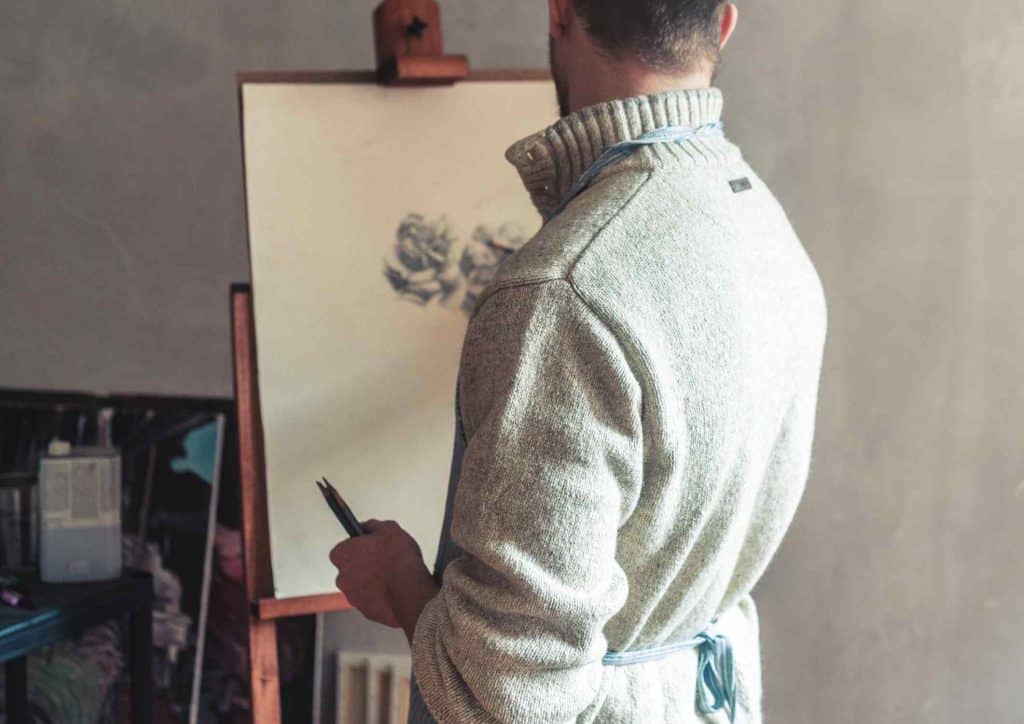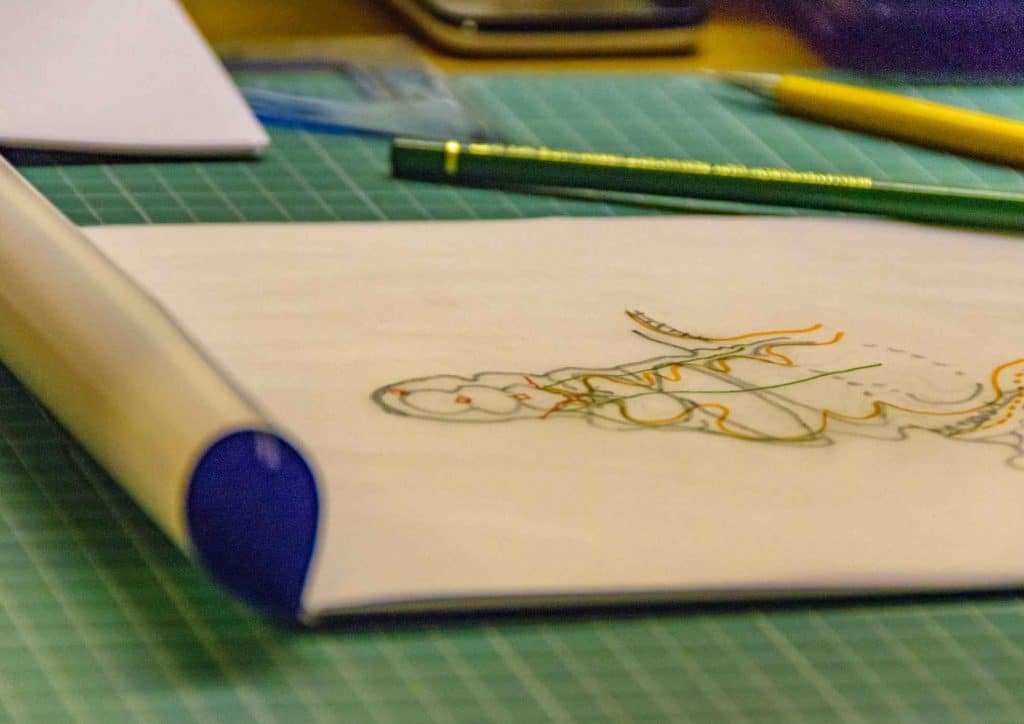Last Updated on April 28, 2023 by Dee
Do you have a box full of old drawings tucked away in a closet somewhere? Wondering how to store drawings? If so, you’re not alone! A lot of people tend to store their artwork in the same way – often without realizing that there are better ways to do it.
In this blog post, we will discuss some tips and tricks for storing your drawings safely and keeping them in good condition for years to come!

How do you store your drawings?
As an artist, it is important to develop disciplined and careful habits when storing your drawings.
Firstly, it is critical to always use acid-free materials, such as archival paper or canvas. This will help protect your artwork and prevent it from deteriorating over time.
Additionally, you should take care to place your drawings in a cool, dark environment where they will not be exposed to direct sunlight or extreme temperatures.
By following these simple guidelines, you can ensure that your drawings will stay in good shape for years to come.
Whether you use them as reference materials or simply enjoy looking at their beauty, it is essential to treat them with the respect they deserve.
[Related article: Digital Painting Tips]
After all, as every artist knows, preserving your work is crucial for maintaining a lifelong passion and creating truly masterful pieces.
How to preserve pencil drawings with fixatives?
There are many different methods for preserving drawings, but perhaps the most effective is using a fixative.
This is a special type of spray or paint that helps to seal the surface of your drawing and protect it from fading or damage.
One of the main benefits of using a fixative is that it can slow down the aging process and help to preserve your work for many years.
To apply a fixative, start by lightly spraying it over your entire drawing in even, gentle motions.
Be sure to use an ample amount in order to fully coat the surface of your artwork, but avoid applying too much at once so that you don’t get drips or any errant splatters on your drawing.
Let the fixative dry completely before handling your work, and check back periodically to make sure there aren’t any signs of fading or discoloration.

Should I always use Fixative?
There is no easy answer to this question, as the best way to preserve your drawings will depend on a number of different factors.
On the one hand, some artists might argue that fixative is important for protecting your work from environmental factors that can cause damage over time.
For example, fixative can help to protect against fading caused by exposure to bright sunlight and humidity changes.
However, other artists may argue that using fixative can also have certain drawbacks.
For example, some types of fixative can alter the appearance of your paper or pencils over time, resulting in a less realistic or vibrant drawing.
[Related Article: Learn How to Start Drawing – 22 Easy Tips to Get you Started!]
How to store big drawings?
Any artist will tell you that storage is an important part of keeping their artwork in good condition.
Big drawings can be especially difficult to store, as they often need to be rolled up and slotted into an archival tube or stored in a very large portfolio holder.
You can also use a piece of cardboard or foam core to help support the rolled-up drawing and keep it from becoming creased or damaged. Make sure to add a piece of acid-free paper between the cardboard or foam core to prevent the yellowing of the paper.
When storing big drawings in an archival tube, be sure to include a desiccant packet to absorb any moisture that might be present.
You can also store big drawings horizontally on a shelf, but be sure to use archival matting or foam core to keep them from sliding around and becoming damaged.
How do artists store their drawings?
When it comes to storing their pastel drawings, charcoal drawings or graphite drawings, professional artists rely on a variety of tools and techniques.
For example, many artists use archival folders or portfolios to protect their fine art from environmental hazards like dust, moisture, and sunlight.
Additionally, many artists keep their finished drawings in a dedicated climate-controlled storage unit that is moisture-free and has minimal or no direct light exposure.
By taking these precautions, artists are able to protect their creations for years and even decades to come.
Ultimately, being a successful artist is as much about protecting your art as it is about creating it in the first place.

Remember: Plastic leads to mold, sunlight fades colors, and other things you need to know before storing artwork…
Artwork is fragile and needs to be stored properly to maintain its condition.
Here are some things you should know before storing your artwork:
- Plastic leads to mold. Mold can damage the surface of your artwork and cause discoloration. Try not to store your drawings in a plastic container.
- Sunlight fades colors. If you’re storing artwork that is sensitive to light, make sure to keep it in a dark, cool location.
- Acidic materials can damage artwork. Things like paper and cardboard can release acids that will discolor and degrade the surface of your artwork over time.
- Invest in archival-quality materials. When it comes to storing artwork, you get what you pay for. Cheap materials are more likely to damage your drawings than high-quality, archival-grade products.
With these things in mind, take care in choosing a location to store your artwork. A dark, cool, dry space is ideal.
Avoid places where there is a lot of foot traffic or where the temperature fluctuates frequently.
Also, make sure that any containers you use are clean and free of acidic materials.
How can you prevent your pencil drawings and fine art from fading or becoming damaged over time?
While it can be exciting to pick up a brand new set of colored pencils or a fresh notebook of drawing paper, one of the biggest challenges every artist faces is how to protect their drawings from fading or becoming damaged over time.
There are a few key strategies that can help you to protect pencil drawings and keep your fine art looking vibrant and beautiful for years to come.
The first thing you should do is make sure that you always use high-quality materials for your artwork. Using the best products available will help to ensure that your pencil drawings remain vibrant even after years of exposure to sunlight or other environmental factors.
Additionally, using the proper storage materials is critical. This may include special art portfolios, archival-quality tape, protective plastic covers, and so on.
Storing fine art in these carefully selected materials will reduce the chances of sun damage and chemical breakdown over time.
At the end of the day, though, no matter how much care you take in preserving your drawings, it’s important not to get too attached to any one piece.
In order to stay inspired and keep moving forward with your art, it can be helpful to think of each drawing as just another stepping stone on your creative journey – something you’ll look back on fondly in years

What should you do if your drawings get wet or stained?
If your drawings get wet or stained, don’t panic! There are a few simple steps you can take to salvage your artwork.
First, gently blot the affected area with a clean cloth to remove any excess moisture.
Then, use a soft-bristled brush to lightly lift any remaining dirt or debris.
Finally, use a dry cloth to absorb any remaining moisture.
If the damage is more severe, you may need to gently scrub the affected area with a mild soap before following the above steps.
If all else fails, you can always try recreating your masterpiece from scratch!
How can I keep my drawings safe in transit?
As an artist, you want your work to be seen and appreciated by others. But how can you display your graphite drawings without damaging them?
The first step is to choose the right material. If you’re using paper, look for acid-free options that will resist discoloration over time.
You may also want to use a mat or frame to protect the drawing from dirt, dust, and other contaminants.
Another option is to scan your drawing and create a digital copy that can be displayed on a website or social media platform.
If you do decide to sell your work, make sure you have a clear understanding of the buyer’s intentions for displaying the piece.
With a little careful planning, you can ensure that your drawings are enjoyed by others for many years to come.

How to preserve and frame a pencil drawing?
A pencil drawing can be a beautiful work of art, but it is also delicate and easily damaged. To help preserve your drawing, it is important to choose the right type of paper and frame.
Paper that is too thin will crumble easily, while paper that is too thick will Yellow and crack over time. Acid-free paper is the best option for long-term preservation.
As for framing, avoid using glass or plastic, as these materials can cause the paper to buckle. Instead, opt for an archival-quality mat board or acrylic glazing.
These materials will help to protect your drawing from UV light and other environmental hazards. With proper care, your pencil drawing can be enjoyed for many years to come.
How to handle paper properly?
As an artist, you know that proper paper handling is essential to keeping your drawings in pristine condition.
Here are a few tips to help you avoid damage to your precious artwork:
- Always use clean, dry hands when handling paper. Whenever possible, avoid touching the surface of the paper directly with your fingers. If your hands are dirty or damp, they can transferring dirt and oils to the paper, which can then cause discoloration or other damage.
- Be careful not to bend or fold the paper. This can cause permanent creases or folds that will mar the appearance of your drawing. If you must store the paper in a way that it will be folded, try interleaving it with another piece of clean paper to help protect it from creasing.
- Avoid exposure to extreme temperatures or changes in humidity. Extreme heat or cold can damage the fibers in the paper, while sudden changes in humidity can cause the paper to warp or buckle. If you must store your drawings in an area that is not temperature-controlled, protect them by placing them in an acid-free sleeve or envelope.
With a little care, you can ensure that your drawings will be safe from damage and will last for many years to come.
Various art storage hacks
There are many different approaches one can take when it comes to storing and preserving art.
Some people prefer to keep their art on display in order to enjoy it and share it with others, while others seek out more specialized art storage solutions in order to preserve their pieces over the long term.
Many of these storage hacks involve using unusual materials or creating DIY solutions that harness the power of existing technology.
For example, some people use UV-blocking glass or infused foil wraps to protect their art from light damage, while others use digital storage devices like flash drives and cloud software to safely archive their pieces for future generations.
No matter what approach you take, there is always room for creativity when it comes to art storage!

Conclusion
If you have been wondering how to store drawings, by following these simple tips, you can ensure that your drawings will be kept in good condition and last for years to come.
Whether you’re a professional artist or an amateur enthusiast, it is important to take the necessary precautions to protect your work.
Have you ever had any art-related disasters? Let us know in the comments below!
Other articles you may enjoy…
Sitting Drawing Reference | 18 Free Poses to Help You with Figure Drawing
